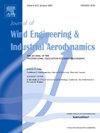Disparities in aeolian sand transport across low and high wind speeds in the atmospheric surface layer
IF 4.9
2区 工程技术
Q1 ENGINEERING, CIVIL
Journal of Wind Engineering and Industrial Aerodynamics
Pub Date : 2025-02-01
DOI:10.1016/j.jweia.2024.105990
引用次数: 0
Abstract
Synchronously measured high-frequency wind speeds and saltation mass flux data were used to investigate the wind-blown sand transport dynamics across low and high wind speeds in the atmospheric surface layer. Our study reveals that the probability density functions (PDFs) of non-zero values of saltation mass flux follow an exponential distribution at relatively low wind speeds (uτ < 0.35 m s−1). However, these PDFs shift to a lognormal distribution at relatively high wind speeds (uτ > 0.45 m s−1). Additionally, the response of saltation mass flux to turbulent motions varies with wind speed. For example, sweep turbulent events contribute 55% to the total saltation mass flux at low wind speeds, whereas they contribute 45% at high wind speeds. Furthermore, Bagnold's formula, Kawamura's formula, and the formula developed by Martin and Kok are effective at high wind speeds. However, due to the intermittency of aeolian sand transport at low wind speeds, these formulas are invalid. We employed the condition-averaged saltation sand transport rate (Qc) to investigate the scaling laws of saltation sand transport rates. Compared to the time-averaged saltation sand transport rate used in previous studies, Qc values align more closely with the formula developed by Martin and Kok.
大气表层低、高风速风沙输运的差异
利用同步测量的高频风速和跃变质量通量数据,研究了大气表层低、高风速下的风沙输运动力学。我们的研究表明,在相对较低的风速下,跃变质量通量非零值的概率密度函数(pdf)遵循指数分布。0.35 m s−1)。然而,这些pdf在相对较高的风速下转变为对数正态分布(uτ >;0.45 m s−1)。此外,跃变质量通量对湍流运动的响应随风速的变化而变化。例如,横扫湍流事件在低风速下贡献了总跃变质量通量的55%,而在高风速下贡献了45%。此外,Bagnold公式,Kawamura公式以及Martin和Kok开发的公式在高风速下有效。然而,由于低风速下风沙输运的间歇性,这些公式是无效的。采用条件平均跳沙输沙率(Qc)研究了跳沙输沙率的标度规律。与之前研究中使用的时间平均跃移输沙率相比,Qc值与Martin和Kok开发的公式更接近。
本文章由计算机程序翻译,如有差异,请以英文原文为准。
求助全文
约1分钟内获得全文
求助全文
来源期刊
CiteScore
8.90
自引率
22.90%
发文量
306
审稿时长
4.4 months
期刊介绍:
The objective of the journal is to provide a means for the publication and interchange of information, on an international basis, on all those aspects of wind engineering that are included in the activities of the International Association for Wind Engineering http://www.iawe.org/. These are: social and economic impact of wind effects; wind characteristics and structure, local wind environments, wind loads and structural response, diffusion, pollutant dispersion and matter transport, wind effects on building heat loss and ventilation, wind effects on transport systems, aerodynamic aspects of wind energy generation, and codification of wind effects.
Papers on these subjects describing full-scale measurements, wind-tunnel simulation studies, computational or theoretical methods are published, as well as papers dealing with the development of techniques and apparatus for wind engineering experiments.

 求助内容:
求助内容: 应助结果提醒方式:
应助结果提醒方式:


